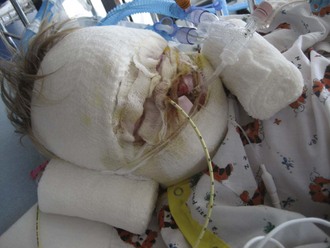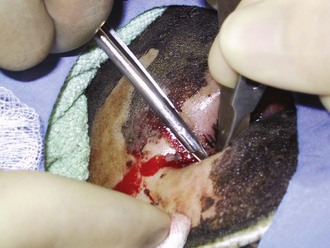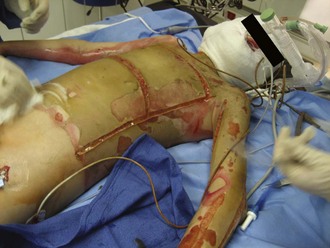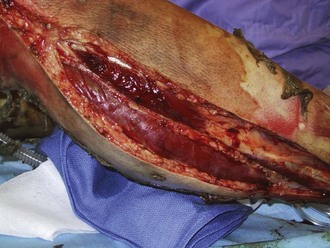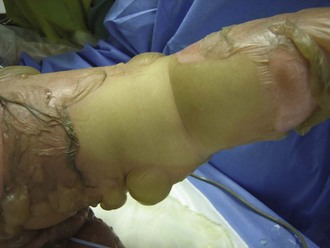206 Burns
Over the past few decades, survival and quality of life have improved markedly for victims of serious burns. A better understanding of injury physiology and realization that the natural history of burns can be changed by prompt surgery led to these improvements.1 Maintenance of patients with serious burns through the physiologic trial of staged wound closure is an essential component of this success. Many aspects of burn critical care are unique to this disease process.2
 Phases of Burn Care
Phases of Burn Care
Successful management of patients with serious burns requires both effective initial resuscitation and development of an overall plan for acute-phase hospitalization. Commonly, this overall plan can be considered to have four phases (Table 206-1).3 The first phase, from day 1 through 3, the initial evaluation and resuscitation phase, focuses on complete evaluation and accurate fluid resuscitation. The second phase, initial wound excision and biological closure, describes changes in the natural history of the disease, which include progressive wound sepsis and systemic inflammation and infection. This phase entails a series of staged operations that are completed during the first few days after injury. The third phase, definitive wound closure, requires that temporary wound covers be replaced with definitive covers and that small complex wounds such as those of the face and hands are addressed. The final stage of care is rehabilitation and reconstruction. Although rehabilitation begins during resuscitation, it becomes much more time consuming and involved near the end of the acute stay. Return to work, school, and community is the major objective of the entire acute hospitalization.
TABLE 206-1 The Four Phases of Burn Care, with Physiologic Changes and Objectives
| Phase and Timing | Physiologic Changes | Objectives |
|---|---|---|
| 1: Initial evaluation and resuscitation,0 to 72 h | Massive capillary leak and burn shock | Accurate fluid resuscitation and thorough evaluation |
| 2: Initial wound excision and biological closure, days 1-7 | Hyperdynamic and catabolic state with high risk of infection | Accurately identify and remove all full-thickness wounds and achieve biological closure |
| 3: Definitive wound closure, day 7 to week 6 | Continued catabolic state and risk of non-wound septic events | Replace temporary with definitive covers, and close small complex wounds |
| 4: Rehabilitation, reconstruction, and reintegration, day 1 through discharge | Waning catabolic state and recovering strength | Initially to maintain range of motion and reduce edema; subsequently to strengthen and facilitate return to home, work, school |
 Physiology of Burn Injury
Physiology of Burn Injury
Serious burns are associated with a stereotypical sequence of physiologic changes. Anticipation of these metabolic aberrations facilitates optimal support (see Table 206-1). During the first 1 or 2 days after a serious burn, patients require substantial hemodynamic support.4 If the patient is successfully resuscitated, a hyperdynamic and hypermetabolic state typically ensues. This later phase, characterized by high cardiac output, reduced afterload, fever, and muscle catabolism, must be supported by provision of adequate quantity and quality of substrates.
Resuscitation Phase
The massive fluid resuscitation required by burn patients is unique in medicine. It is secondary to a diffuse but transient capillary leak driven by poorly characterized mediators.5 The clinical result is extravasation of fluids, electrolytes, and even moderate-sized colloid molecules into both burned and unburned soft tissues to a degree not seen in other disease processes. Since the 1930s, a variety of resuscitation formulas have been developed based on burn and patient size. However, this remains an area of clinical art, with no formula being reliably accurate for all patients.2 Besides burn size and patient size, a variety of other factors have an impact on resuscitation requirements. These include delay in initiation of resuscitation, inhalation injury, patient age, baseline cardiovascular health, and the depth and vapor transmission characteristics of the wound itself.6
Burns under 15% generally do not require a formal fluid resuscitation program. As burn size increases, physiologic aberrations increase in intensity, explaining escalating volume requirements. Formulas do not accurately predict the needs of individual patients. Optimal burn resuscitation requires hourly reevaluation of resuscitation endpoints, with titration of volume infusions. In essence, the formula chosen will only help initiate resuscitation and roughly guide planning of volume needs. Of the many resuscitation formulas available, the modified Brooke protocol (Box 206-1) is representative. All formulas have their adherents, and all are useful if employed as rough guidelines only while monitoring physiologic resuscitation endpoints. The role of colloid is expanding in burn resuscitation, although there is no uniform agreement. Many providers, the author included, begin 5% albumin at a maintenance rate immediately during resuscitation and find it reduces the incidence of edema-related complications, including abdominal compartment syndrome.7
Box 206-1
Modified Brooke Resuscitation Formula
24-48 Hours
Hyperdynamic Phase
Typically there is a very noticeable decline in intravenous volume requirements 18 to 30 hours after injury. It is assumed that this is because the capillary leak has “sealed” in well-resuscitated patients. After this hypodynamic period, a systemic hypermetabolic state predictably develops and is sustained in surviving patients until it slowly regresses, well after wound closure.8 This state is characterized by high cardiac output, low peripheral vascular resistance, fever, and increased protein flux. In patients not well supported with protein substrate, this increased protein flux will be associated with significant muscle catabolism. Although the basic biology is not well understood, the postresuscitation physiologic state is assumed to be caused by inflammatory mediators and augmented release of the counterregulatory hormones, cortisol, catecholamines, and glucagon.9 These hormonal changes are triggered by a combination of wound- and gut-released bacteria and their byproducts, pain, foci of infection, and some degree of evaporative heat loss.
A central component of burn critical care is to ensure adequate support of the hypermetabolic state. This is done by providing accurate fluid repletion, adequate supplies of metabolic substrates, control of environmental temperature, and competent pain control. Early identification and excision of necrotic skin and soft tissue with immediate biological closure of the resulting wounds truncates the hypermetabolic physiologic state and is the most effective way to avoid the deleterious consequences of prolonged hypermetabolism.10
Burn critical care requires control of the patient’s environmental temperature. Burn patients have enormous and invisible evaporative water and energy losses if they are maintained in the typical cool dry air of a general hospital.11 Burn units and burn operating rooms must be engineered to maintain high ambient temperature and humidity to avoid the difficult problem of hypothermia and excessive energy loss.
 Initial Evaluation and Burn-Specific Secondary Survey
Initial Evaluation and Burn-Specific Secondary Survey
Burn patients often spend many hours in transport before reaching the location of definitive care, and their initial evaluation and management must be completed outside the burn unit setting. Often when patients arrive in the intensive care unit (ICU) where definitive care will be rendered, a complete burn-specific secondary survey has not been completed.12 It is essential for the intensivist to have a familiarity with these issues so burn-related pathology and coexisting injuries are not overlooked. Evaluations should follow the format taught by the Advanced Trauma Life Support course. All seriously burned patients should be approached as having potential multiple trauma.13
Initial Evaluation
The primary survey of the burn patient is similar to that of the trauma patient, although there are a few important differences worthy of emphasis. First among these is the progressive mucosal edema that may compromise airway patency in the early hours after burns. This is especially true in young children because of their much smaller airway.14 Progressive stridor or hoarseness should prompt visualization and/or intubation of the airway. Ideally, this need is anticipated before the crisis stage so proper equipment and personnel can be gathered, facilitating smooth tube placement. The facial and airway edema that is so common makes the burn patient’s airway among the most challenging to control. Reintubation can be exceedingly difficult if not impossible after airway edema has progressed, making accidental extubation a potentially lethal complication. Security of the endotracheal tube should be regularly assessed. A twill-tie harness is a reliable method of securing the endotracheal tube (Figure 206-1).
Burn-Specific Secondary Survey
The ocular and otolaryngologic examination should begin with palpation of the head and face for signs of coincident blunt or penetrating trauma. The globes should be examined early, prior to the development of facial and eyelid edema, which will limit examination (Figure 206-2).15 Serious globe burns impart a clouded appearance to the cornea, and fluorescein staining will detect more subtle injuries. Tarsorrhaphy is virtually never indicated acutely, because lid edema will generally provide excellent globe coverage even in the presence of serious lid burns. Pressure on the burned ear and occiput is avoided. Topical mafenide acetate is applied, as it will penetrate the relatively avascular underlying cartilage.16 Signs of inhalation injury, such as carbonaceous debris and singed nasal hairs, are noted on examination of the nose and throat. Ties securing endotracheal and nasogastric tubes should be checked so that pressure on the nasal septum or oral commissures is avoided.
The initial neurologic evaluation centers on exclusion of coincident neurologic injury and control of pain and anxiety. Even if they arrive alert and oriented, patients with serious burns typically become obtunded over the succeeding hours and days, if only because of the effects of pain medications and sleep deprivation. It is therefore important to exclude central nervous system trauma if the mechanism of injury is either unknown or consistent with such trauma. There should be a low threshold for ordering a computed tomographic scan of the head and spine, based on mechanism of injury. Pain and anxiety management should begin during the initial evaluation, within limits of safety.17 Good pain control may have physiologic as well as the obvious psychological benefits. In the emergency setting, this is best done with incremental administration of small doses of narcotics and benzodiazepines. When caring for paralyzed or obtunded patients, it is important to make sure there is no pressure on peripheral nerves, so that neuropathies are avoided. Finally, those burned in structural fires should be assessed for carbon monoxide (CO) exposure by history, neurologic examination, and determination of a carboxyhemoglobin level, because selected patients with significant exposure may benefit from hyperbaric oxygen treatment.18
The chest wall should be assessed for compliance and symmetrical air movement. Patients with deep near-circumferential or circumferential chest wall burns may require escharotomy to facilitate ventilation (Figure 206-3). If properly performed, escharotomy of the torso markedly enhances compliance.
Most patients are hypovolemic at the time of presentation and respond promptly to volume administration. Some patients, especially the elderly, will have previously unsuspected myocardial disease that may become clinically important during the stress of resuscitation. Some data also exist to support the existence of a myocardial depressant factor in some patients with very extensive injuries.19 Patients who do not respond as expected to calculated resuscitation volumes may benefit from invasive monitoring, pulmonary artery catheterization, or cardiac ultrasonography.
Perhaps the most important component of evaluating the extremities is to identify areas at risk for loss of perfusion with progressive edema during resuscitation and to develop an effective monitoring plan. Resuscitation-associated edema can cause profound limb ischemia secondary to swelling under a circumferential eschar or within inelastic muscle compartments. This complication is seen in patients who have suffered deep extremity burns (especially if circumferential) or high-voltage electrical injuries. Low-pressure flow in the extremity should be monitored, commonly using a Doppler probe to demonstrate flow in the palmar arch or digital vessels, because capillary perfusion pressure is only one-third the mean arterial pressure monitored in larger vessels. Prompt identification of ischemic extremities is essential so that escharotomy (Figure 206-4) or fasciotomy (Figure 206-5) can be effected in a timely manner.20

Figure 206-4 Properly performed escharotomy will result in immediate improvement in extremity blood flow.
Abuse or neglect should be considered when evaluating all burns, not just those in young children. Approximately 20% of burns in young children are reported to state authorities for investigation, but abuse occurs in all age groups.21 Burns can also be a result of domestic violence or other interpersonal assaults. Often this determination is not made until the patient has been admitted to the ICU. Suspicious cases should be filed with appropriate state agencies. Documentation of the stated injury circumstances and of the wounds is essential. Wound photography is ideal (Figure 206-6).
 Fluid Resuscitation
Fluid Resuscitation
In the first 1 or 2 hours after a large burn, patients experience little change in intravascular volume or hemodynamics. In fact, patients are often remarkably alert during this period. In the hours that follow, however, the wound releases mediators that are absorbed into the systemic circulation. In addition, stress-related hormones are secreted, and reactive oxygen species are formed on reperfusion of marginally perfused tissues. These and perhaps other factors trigger a diffuse loss of capillary integrity, resulting in extravasation of fluids, electrolytes, and even moderate-sized colloid molecules into soft tissues, including tissues distant from the burn. This remarkable physiologic phenomenon, the so-called capillary leak, abates 18 to 24 hours later and explains the unique resuscitation needs of patients who have sustained large burns. Predicting resuscitation requirements of specific patients involves multiple variables besides burn size: burn depth, vapor transmission characteristics of the wound, patient age and cardiovascular health, resuscitation delay, environmental temperature and humidity, and presence or absence of concomitant inhalation injury. Numerous formulas have been promulgated to roughly guide resuscitation efforts, but none is accurate in every patient.6,22 A common consensus formula is the modified Brooke formula summarized in Box 206-1. The role of colloid is expanding in burn resuscitation, although there is no uniform agreement. Many providers, the author included, begin 5% albumin at a maintenance rate immediately during resuscitation of patients with larger injuries and find it reduces the incidence of edema-related complications including abdominal compartment syndrome.7 Patients not responding as predicted to resuscitation efforts should have serum levels of cortisol checked, particularly if cryptic hypotension, hypernatremia, and/or hypokalemia are also in evidence. Inaccurate fluid resuscitation will cause significant morbidity. Formulas can only help determine initial volume infusion rates and roughly predict 24-hour volume requirements; they are so inherently inaccurate that resuscitation should be guided by hourly reevaluation of clinical endpoints. Resuscitation endpoints are summarized in Table 206-2. Measured oxygen delivery and consumption have been used as adjunctive resuscitation guides but are not necessary in the vast majority of patients.
TABLE 206-2 Age-Specific Resuscitation Endpoints
| Resuscitation Endpoint | Resuscitation Target |
|---|---|
| Sensorium | Comfortable, arousable |
| Physical examination | Warm extremities, full peripheral pulses |
| Urine output | Infants: 1-2 mL/kg/h; children: 0.5-1 mL/kg/h; all others: 0.5 mL/kg/h |
| Base deficit | Less than 2 |
| Systolic blood pressure | Infants: 60-70 mm Hg |
| Children: 70-90 + (twice age in years) mm Hg | |
| Adolescents and adults: 90-120 mm Hg |
Note: Age-specific resuscitation endpoints should be assessed regularly throughout burn resuscitation and infusions adjusted up or down in 10% to 20% increments to meet needs of the individual patient.
 Burn Critical Care Issues
Burn Critical Care Issues
Airway Issues
Dangerous and frightening emergencies in the seriously burned involve the airway. Although evaluation and control of the airway are part of the initial evaluation, concerns extend throughout the period of intensive care. Endotracheal tube security should be part of the regular reevaluation of every patient in the burn ICU, because facial and hypopharyngeal edema can make reintubation after unplanned extubation incredibly difficult.23
Inhalation Injury
Inhalation injury remains a clinical diagnosis.24 A history of closed-space fire, the presence of singed nasal hairs and facial burns, and carbonaceous sputum support the diagnosis of inhalation injury. Fiberoptic bronchoscopy can be useful in equivocal cases, as can technetium scanning. However, in the large majority of patients, the diagnosis is made by history and physical examination. The initial chest radiograph is almost always normal, as are gas exchange and compliance until the endobronchial mucosa sloughs several days later, occluding small airways and leading to subsegmental atelectasis and respiratory insufficiency.
Five clinical consequences commonly occur in patients with inhalation injury: acute upper airway obstruction, bronchospasm, small airway occlusion, pulmonary infection, and respiratory failure.25 Airway obstruction and bronchospasm are early complications, typically appearing the first day. Airway edema and obstruction are managed with endotracheal intubation. Bronchospasm from aerosolized irritants can be particularly intense during the first 24 to 48 hours and is managed with in-line nebulization β-adrenergic agonists, with infrequent use of intravenous bronchodilators such as terbutaline or low-dose epinephrine infusions. Ventilatory strategies should be designed to minimize automatic positive end-expiratory pressure in this setting.
Respiratory failure is unfortunately common in patients with inhalation injury and can be well managed with a pressure-limited ventilation strategy based on permissive hypercapnia.26 Patients who fail this can sometimes benefit from investigational modes of support such as inhaled nitric oxide or extracorporeal oxygenation, although the utility of the latter is quite limited in burn patients, owing to the need for anticoagulation.27,28

Full access? Get Clinical Tree


